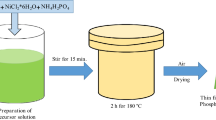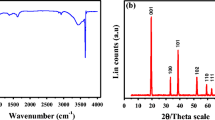Abstract
Hybrid supercapacitors with nickel hydroxide electrode are widely used as modern power sources for electrovehicles, ignition of different electric engines, etc. Nickel hydroxide for supercapacitor use must satisfy special features which are quite different from those requested for battery application. The aim of this work is to improve the promising two-stage high-temperature method by altering hydrolysis condition (hot and cold) in order to obtain Ni(OH)2 with improved electrochemical activity. Ni(OH)2 samples have been investigated by PXRD, TG, DSC, SEM, TEM, cyclic voltammogramm, and galvanostatic charge-discharge cycling. It has been established from PXRD, TG, and DSC analyses that material obtained by hydrolysis at high temperature is a highly crystalline β-Ni(OH)2 characterized by high thermal stability. Materials prepared by cold hydrolysis are a highly defective βbc-Ni(OH)2, with 6.3 % water content and a lower thermal stability. It has been shown that samples prepared by hot hydrolysis have a high redox reversibility and electrochemical cycling stability, but a lower electrochemical capacity. This suggests that the electrochemical processes are localized in the thin layer at the particle surface. Cyclic voltammograms of samples prepared by cold hydrolysis exhibit gradual activation of the active material, anyhow resulting in higher capacity. By means of the galvanostatic charge-discharge curves at different current densities, the specific capacities of the samples have been calculated. The sample prepared by cold hydrolysis has higher specific capacities than the sample prepared by hot hydrolysis.







Similar content being viewed by others
References
Simon P, Gogotsi Y (2008) Materials for electrochemical capacitors. Nat Mater 7(11):845–854
Burke A (2007) R&D considerations for the performance and application of electrochemical capacitors. Elec Acta 53:1083–1091
Lang J-W, Kong L-B, Wu W-J, Liu M, Luo Y-C, Kang L (2009) A facile approach to the preparation of loose-packed Ni(OH)2 nanoflake materials for electrochemical capacitors. J Solid State Electrochem 13:333–340
Min S, Zhao C, Chen G, Qian X (2014) One-pot hydrothermal synthesis of reduced graphene oxide/Ni(OH)2 films on nickel foam for high performance supercapacitors. Elec. Acta 115:155–164
Lang J-W, Kong L-B, Liu M, Luo Y-C, Kang L (2010) Asymmetric supercapacitors based on stabilized α-Ni(OH)2 and activated carbon. J Solid State Electrochem 14:1533–1539
Aghazadeh M, Ghaemi M, Sabour B, Dalvand S (2014) Electrochemical preparation of α-Ni(OH)2 ultrafine nanoparticles for high-performance supercapacitors. J Solid State Electrochem 18:1569–1584
Zheng C-H, Xin L, Zhi-Dao C, Wu Z-F, Dao-Lai F (2014) Excellent supercapacitive performance of a reduced graphene oxide/Ni(OH)2 composite synthesized by a facile hydrothermal route. J Cent South Univ 21:2596–2603
Bo W, Gareth WR, Zheng C, Jiang M, Liu J, Lei X, Sun X (2014) Hierarchical NiAl layered double hydroxide/multiwalled carbon nanotube/nickel foam electrodes with excellent pseudocapacitive properties. ACS Appl Mater Interfaces 6:16304–16311
Ramesh TN, Vishnu Kamath P (2006) Synthesis of nickel hydroxide: effect of precipitation conditions on phase selectivity and structural disorder. J Power Sources 156:655–661
Ramesh TN, Vishnu Kamath P, Shivakumara C (2005) Correlation of structural disorder with the reversible discharge capacity of nickel hydroxide electrode. J Electrochem Soc 152(4):A806–A810
Zhao Y, Zhu Z, Zhuang Q-K (2006) The relationship of spherical nano-Ni(OH)2 microstructure with its voltammetric behavior. J Solid State Electrochem 10:914–919
Delmas C, Tessier C (1997) Stacking faults in the structure of nickel hydroxide: a rationale of its high electrochemical activity. J Mater Chem 7(8):1439–1443
Quansheng S, Tanga Z, Hetong G, Chan SLI (2002) Structural characteristics of nickel hydroxide synthesized by a chemical precipitation route under different pH values. J Power Sources 112:428–434
Jayashree RS, Vishnu Kamath P, Subbannab GN (2000) The effect of crystallinity on the reversible discharge capacity of nickel hydroxide. J Electrochem Soc 147(6):2029–2032
Jayashree RS, Vishnu Kamath P (1999) Factors governing the electrochemical synthesis of a-nickel (II) hydroxide. J Appl Electrochem 29:449–454
Wang K, Li L, Zhang T (2013) Synthesis of nickel hydroxide and its electrochemical performances. Int J Electrochem Sci 8:6252–6257
Rajamathi M, Vishnu Kamatha P, Seshadrib R (2000) Polymorphism in nickel hydroxide: role of interstratifications. J Mater Chem 10:503–506
Yanga L-X, Zhua Y-J, Tonga H, Lianga Z-H (2007) Hydrothermal synthesis of nickel hydroxide nanostructures in mixed solvents of water and alcohol. J Solid State Chem 180:2095–2101
Xu L, Ding Y-S, Chen C-H, Zhao L, Rimkus C, Joesten R, Suib SL (2008) 3D flowerlike r-nickel hydroxide with enhanced electrochemical activity synthesized by microwave-assisted hydrothermal method. Chem Mater 20:308–316
Liua C, Lib Y (2009) Synthesis and characterization of amorphous α-nickel hydroxide. J Alloys Compd 478:415–418
Bora M (2003) Homogeneous precipitation of nickel hydroxide powders. Retrospective Theses and Dissertations. 731.
Cordoba de Torresi SI, Provazi K, Malta M, Torresib RM (2001) Effect of additives in the stabilization of the α phase of Ni(OH)2 electrodes. J Electrochem Soc 148:A1179–A1184
Kotok VA, Koshel ND, Kovalenko VL, Grechanuk AA (2008) The stability of aluminium-substituted alpha-nickel hydroxide. First Regional Symposium on Electrochemistry of South-East Europe “RSE-SEE”: Book of international conference Croatia Rovinj:201–203.
Liu B, Wang XY, Yuan HT, Zhang YS, Song DY, Zhou ZX (1999) Physical and electrochemical characteristics of aluminium-substituted nickel hydroxide. J Appl Electrochem 29:855–860
Li YW, Yao JH, Liu CJ, Zhao WM, Deng WX, Zhong SK (2010) Effect of interlayer anions on the electrochemical performance of Al-substituted a-type nickel hydroxide electrodes. Int J Hydrog Energy 35:2539–2545
Zhen FZ, Quan JW, Min YL, Peng Z, Jun JL (2004) A study on the structure and electrochemical characteristics of a Ni/Al double hydroxide. Met Mater Int 5(10):485–488
Zhaoa YL, Wanga JM, Chena H, Pana T, Zhanga JQ, Caoa CN (2004) Al-substituted nickel hydroxide prepared by homogeneous precipitation method with urea. Int J Hydrog Energy 29:889–896
Faour A, Mousty C, Prevot V, Devouard B, Roy AD, Bordet P, Elkaim E, Taviot-Gueho C (2012) Correlation among structure, microstructure, and electrochemical properties of NiAl − CO3 layered double hydroxide thin films. J Phys Chem 116:15646–15659
Hu M, Lei L (2007) Effects of particle size on the electrochemical performances of a layered double hydroxide, [Ni4Al(OH)10]NO3. J Solid State Electrochem 11:847–852
Akiko S, Shintaro I, Hanawa K (1999) Preparation and characterization of Ni/Al-layered double hydroxide. J Electrochem Soc 146(4):1251–1255
Caravaggio AG, Detellier C, Wronski Z (2001) Synthesis, stability and electrochemical properties of NiAl and NiV layered double hydroxides. J Mater Chem 11:912–921
Zhongju Z, Zhu Y, Bao J, Zhuojun Z, Lin X, Zheng H (2012) Structural and electrochemical performance of additives-doped α-Ni(OH)2. Journal of Wuhan University of Technology-Mater. Sci Ed 4(27):538–541
Chena H, Wanga JM, Pana T, Zhaoa YL, Zhanga JQ, Caoa CN (2005) The structure and electrochemical performance of spherica Al-substituted-Ni(OH)2 for alkaline rechargeable batteries. J Power Sources 143:243–255
Wang CY, Zhong S, Konstantinov K, Walter G, Liu HK (2002) Structural study of Al-substituted nickel hydroxide. Solid State Ionics 148:503–508
Vasserman IN (1980) Khimicheskoe osazdenie is rastvorov (Chemical precipitation from solutions). Leningrad. Khimia, 208.
Li Q, Ni H, Cai Y, Cai X, Liu Y, Chen G, Fan L-Z, Wanga Y (2013) Preparation and supercapacitor application of the single crystal nickel hydroxide and oxide nanosheets. Mater Res Bull 48:3518–3526
Bin Fang, Aixia Gu, Guangfeng Wang, Bo Li, Cuihong Zhang, Yongyi Fang, Xiaojun Zhang (2009) Synthesis hexagonal ß-Ni(OH)2 nanosheets for use in electrochemistry sensors. Microchim Acta 167:47–52.
Hermet P, Gourrier L, Bantignies J-L, Ravot D, Michel T, Deabate S, Boulet P, Henn F (2011) Dielectric, magnetic, and phonon properties of nickel hydroxide. Phys Rev B 84:235211
Gourrier L, Deabate S, Michel T, Paillet M, Hermet P, Bantignies J-L, Henn F (2011) Characterization of unusually large “pseudo-single crystal”of β-nickel hydroxide. J Phys Chem C 115:15067–15074
Li N, Zhang Y, Kong D, Zhou Q, Chen X, Hui S (2013) Fluid particle group reaction model and experimental verification. Adv Powder Technol 24(1):200–206
Nikolenko NV, Esajenko EE (2005) Surface properties of synthetic calcium hydroxyapatite. Adsorpt Sci Technol 23(7):543–553
Knorr T, Kaiser M, Glenk F, Etzold BJM (2012) Shrinking core like fluid solid reactions—a dispersion model accounting for fluid phase volume change and solid phase particle size distributions. Chem Eng Sci 69(1):492–502
Oliva P, Leonardi J, Laurent JF, Delmas C, Braconnier JJ, Figlarz M, Fievet F, de Guibert A (1982) Review of the structure and the electrochemistry of nickel hydroxides and oxy-hydroxides. J Power Sources 8(2):229–255
Watanabe K, Kikuoka T, Kumagai N (1995) Physical and electrochemical characteristics of nickel hydroxide as a positive material for rechargeable alkaline batteries. J Appl Electrochem 25:219–226
Faure C, Delmas C, Fouassier M, Willmann P (1991) Preparation and characterization of cobalt-substituted a-nickel hydroxides stable in potassium hydroxide medium. Part I. a’-hydroxide with an ordered packing. J Power Sources 35(3):249–261
Deabate S, Henn F (2005) Structural modifications and electrochemical behavior of the β(II)-Ni(OH)2/β(III)-NiOOH redox couple upon galvanostatic charging/discharging cycling. Elec. Acta (50): 2823–2835.
Acknowledgments
This study was carried out in frame of an international collaboration agreement between University Montpellier (Montpellier, France), Ukrainian State University of Chemical Technology (Dnipropetrovsk, Ukraine), and Vyatka State University (Kirov, Russian Federation) no. 130585 from July 7, 2014. V.A. Kotok is grateful to the French Embassy in Kiev for its financial support.
Author information
Authors and Affiliations
Corresponding author
Rights and permissions
About this article
Cite this article
Kovalenko, V., Kotok, V., Sykchin, A. et al. Nickel hydroxide obtained by high-temperature two-step synthesis as an effective material for supercapacitor applications. J Solid State Electrochem 21, 683–691 (2017). https://doi.org/10.1007/s10008-016-3405-2
Received:
Revised:
Accepted:
Published:
Issue Date:
DOI: https://doi.org/10.1007/s10008-016-3405-2




